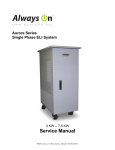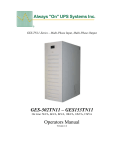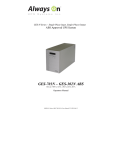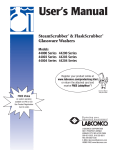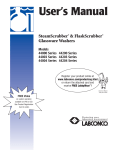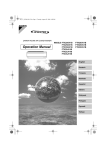Download Service Manual
Transcript
Aurora Series Single Phase ELI System 10 KW – 15 KW Service Manual M4006_Aurora_10-15Kw_Service_Manual V3.0 2012-06-14 M4006_Aurora_10-15Kw_Service_Manual V3.0 2012-06-14 i NOTE The instructions contained in this manual are not intended to cover all of the details or variations in equipment, or to provide for every possible contingency to be met in connection with installation, operation, or maintenance. Should further information be desired or should particular problems arise which are not covered sufficiently for the purchaser’s purposes, the matter should be referred directly to Always On. Any electrical or mechanical modifications to this equipment, without prior written consent of Always On, will void all warranties and may void UL/cUL listing. Unauthorized modifications may also result in personal injury, death, and damage to the equipment. Dear Customer, Thank you for selecting our emergency lighting inverter (ELI). We are pleased to include you as one of our valued Always On customers! We are confident that this emergency lighting inverter system, developed and manufactured in our ISO 9001 certified facilities, will provide the quality and satisfaction you demand. Please read this installation manual carefully as it contains the necessary information required to install the ELI properly. Thank you for choosing Always On. M4006_Aurora_10-15Kw_Service_Manual V3.0 2012-06-14 ii Preface Congratulations on your choice of our emergency lighting inverter (ELI). This equipment has been manufactured and tested using methods and procedures equivalent to UL 924. This manual describes the recommended procedures for installing the ELI. While every effort has been made to ensure the completeness and accuracy of this manual, Always On assumes no responsibility or liability for any losses or damages resulting from the use of the information contained in this document. WARNING: This manual is intended to provide installation instructions only. The information contained in this manual is to be used as a guideline and recommendation only. Only qualified personnel should perform installation and maintenance. Factory authorized personnel shall inspect installation prior to start up and commissioning to validate warranty. Failure to follow this directive will void the warranty. We recommend that this manual be kept with the ELI for future reference. If any problems are encountered with the procedures contained in this manual, please contact our Service Centre before proceeding. This document may not be copied or reproduced without the explicit written permission of Always On. Due to technical advancements and improvements, some of the information contained in this manual may be changed or modified without prior notice. M4006_Aurora_10-15Kw_Service_Manual V3.0 2012-06-14 iii Symbols The following symbols are used through out this manual. Warning Information This symbol alerts you to important information. Electrical Hazard This symbol indicates an electrical hazard may be present. Electrical Symbols Protective grounding terminal; a terminal that must be connected to ground prior to making any other connection to the equipment. A terminal to/from which an alternating current or voltage may be applied/supplied. A terminal to/from which a direct current or voltage may be applied/supplied. This symbol indicates the word “phase”. M4006_Aurora_10-15Kw_Service_Manual V3.0 2012-06-14 iv Safety Instructions READ AND FOLLOW ALL SAFETY INSTRUCTIONS. SAVE THESE INSTRUCTIONS. This manual contains important safety instructions that should be followed during installation and maintenance of the ELI system and optional packages. Before the installation process begins, we recommend that the installer read through the safety precautions, operators manual and the option installation instructions, taking all necessary safety precautions to protect themselves and the equipment being installed. GENERAL Move the ELI in an upright position, in its original packaging, to its final destination. To lift the cabinets, use a forklift or lifting belts with spreader bars. - Check for sufficient floor and elevator loading capacity. - Check the integrity of the ELI equipment carefully. If visible damage is evident, do not attempt to install or start the ELI. Contact the transport delivery company immediately, file a claim with the transport company and inform Always On directly. - Do not use outdoors - The use of accessory equipment not recommended by Always On may cause an unsafe condition - WARNING! RISK OF ELECTRICAL SHOCK: use extreme caution when removing covers. - All maintenance and service work should be performed by qualified and trained service personnel. The ELI may contain its own energy source, (batteries) which can be dangerous to the untrained person. This ELI contains potentially hazardous voltages - The field-wiring terminals may be electrically live, even when the ELI is not connected to the utility. - Use caution when servicing batteries. A battery can present a risk of electrical shock, burn from high short-current. Battery acid can cause burns to skin and eyes. If acid is spilled on skin or in eyes, flush with fresh water and contact physician immediately. - When replacing batteries use the same number and type (sealed-cell lead acid). - Proper disposal of batteries is required. Refer to your local codes for disposal requirements. M4006_Aurora_10-15Kw_Service_Manual V3.0 2012-06-14 v - Dangerous voltages may be present during battery operation. The batteries must be disconnected during maintenance or service work. (Open battery breaker or fuses) - Be aware that the inverter can restart automatically after the utility voltage is restored. Do not use this equipment for other than intended use. M4006_Aurora_10-15Kw_Service_Manual V3.0 2012-06-14 vi INSTALLATION - This ELI is intended for use in a controlled indoor environment free of conductive contaminants and protected against any type of intrusion. Do not install the ELI in an excessively humid environment or near water. Avoid spilling liquids and/or dropping any foreign object(s) onto the ELI. The unit must be placed in a sufficiently ventilated area; the ambient temperature should not exceed 40°C (104°F). Optimal battery life is obtained if the ambient temperature does not exceed 25°C (77°F). HIGH GROUND LEAKAGE CURRENT: ground connection completed before connecting the AC voltage wires on the input! Switching OFF the ELI does not isolate the ELI from the utility as the utility supply is still HOT at the input terminal strip. Supply breaker needs to be opened. It is important that air can move freely around and through the unit. Do not block the air vents. Avoid locations in direct sunlight or near heat sources (gas or electric heaters). STORAGE - Store the ELI in a dry location free of contaminants; Storage temperature must be within -25°C (-13°F) to 55°C (131°F). If the unit is stored for a period exceeding 3 months, the batteries must be recharged periodically (time depending on storage temperature). WARNING! LETHAL VOLTAGES MAY BE PRESENT WITHIN THIS UNIT EVEN WHEN IT IS APPARENTLY NOT OPERATING. OBSERVE ALL CAUTIONS AND WARNINGS IN THIS MANUAL. FAILURE TO DO SO COULD RESULT IN SERIOUS INJURY OR DEATH. REFER UNIT TO QUALIFIED SERVICE PERSONNEL IF MAINTENANCE IS REQUIRED. NO ONE SHOULD WORK ON THIS EQUIPMENT UNLESS THEY ARE FULLY QUALIFIED TO DO SO. AN INSTALLER SHOULD NEVER WORK ALONE. WARNING! WHEN REMOVING POWER FROM THE ELI, ALLOW FIVE MINUTES FOR CAPACITORS TO DISCHARGE BEFORE WORKING ON THE EQUIPMENT. CAUTION! This equipment complies with the requirements in Part 15 of FCC rules for a Class A computing device. Operation of this equipment in a residential area may cause interference to radio and TV reception, requiring the operator to take whatever steps necessary to correct the interference. CAUTION! Do not put option control wiring in the same conduit as the ELI input or output power cables. M4006_Aurora_10-15Kw_Service_Manual V3.0 2012-06-14 vii THIS SAFETY NOTICE IS ADDRESSED TO THE ALWAYS ON CUSTOMER ENGINEERS WHO PERFORM MAINTENANCE OF THE UNINTERRUPTIBLE POWER SUPPLY (ELI) SYSTEMS. Electrical Safety • Maintenance work to be performed by a factory trained customer engineers, or qualified personnel. Extremely dangerous voltage levels can exist within the ELI system. Extreme caution must be used. • Ensure system is in maintenance bypass mode or external wrap-around bypass mode before work is started. • This manual is designed as an aid tool in diagnosing problems that may arise. Always On does not assume responsibility if information causes injuries. • Apart from the front door, do not open any other part of the ELI without consulting the factory first. Before removing the protection screens, be sure that the unit is completely powered off. • Be aware that dangerous voltage can be supplied by the internal battery or electrolytic capacitors. • When system is in bypass mode and all fuses have been opened dangerous voltages may exist within the ELI system. Use extreme caution when exchanging boards and working inside the unit. READ AND FOLLOW ALL SAFETY INSTRUCTIONS. SAVE THESE INSTRUCTIONS. M4006_Aurora_10-15Kw_Service_Manual V3.0 2012-06-14 viii TABLE OF CONTENTS 1. 2. 3. 4. 5. 6. Introduction............................................................................................................................... 1 1.1. Overview........................................................................................................................... 1 1.2. Features............................................................................................................................ 1 1.3. Definitions......................................................................................................................... 2 Theory of Operation ................................................................................................................ 3 2.1. Block Diagram.................................................................................................................. 3 2.2. ELI Subsystems............................................................................................................... 4 2.3. Modes of Operation ........................................................................................................ 5 Physical Topology ................................................................................................................... 7 3.1. Front view ......................................................................................................................... 7 3.2. Battery Cabinets .............................................................................................................. 9 User Interface ........................................................................................................................ 10 4.1. Front Control Panel....................................................................................................... 10 4.2. Normal Display .............................................................................................................. 10 4.3. Button Operation ........................................................................................................... 10 4.4. ELI Metering Display..................................................................................................... 12 4.5. Control Panel Lights...................................................................................................... 12 4.6. Audible Alarm................................................................................................................. 12 Communication Interfaces ................................................................................................... 13 5.1. RS-232 Port.................................................................................................................... 14 5.2. AS-400 & Relay Contact Port...................................................................................... 14 5.3. Dry Contact .................................................................................................................... 16 5.4. Emergency Power Off .................................................................................................. 16 5.5. Emergency Lighting Notification ................................................................................. 17 Optional Features.................................................................................................................. 18 6.1. Simple Network Management Protocol (SNMP) Adapter....................................... 18 6.2. Monitoring and Optional Control Software ................................................................ 18 M4006_Aurora_10-15Kw_Service_Manual V3.0 2012-06-14 ix 6.3. 7. Normally Off Function................................................................................................... 18 OPERATION .......................................................................................................................... 19 7.1. Start-up Procedure........................................................................................................ 19 7.2. Shutdown Procedure .................................................................................................... 19 7.3. Test Procedure .............................................................................................................. 20 7.4. Maintenance Bypass Procedure................................................................................. 20 7.5. Manual Battery Test:..................................................................................................... 21 8. TROUBLESHOOTING ......................................................................................................... 22 9. Layout Details ........................................................................................................................ 23 9.1. Circuit Boards ................................................................................................................ 23 9.2. 10 kW to 15 kW Unit Pictures – Layout ..................................................................... 24 10. Technical Specifications................................................................................................... 28 11. Contact Information........................................................................................................... 32 M4006_Aurora_10-15Kw_Service_Manual V3.0 2012-06-14 x 1. INTRODUCTION Congratulations on your choice of the Aurora On-Line Emergency Lighting Inverter (ELI). This ELI features the latest top of the line microprocessor technology and IGBT transistors and provides clean, highly regulated and pulse width modulated (PWM) true sine wave power. 1.1. Overview This ELI is designed for installation between your AC power supply (utility or generator) and your lighting equipment. It provides power to your equipment during major power events such as blackouts and brownouts, over-voltage and under-voltage conditions. The ELI provides a consistent supply of regulated AC power during these power events, allowing you to ensure safety and lighting for the period required. 1.2. Features This ELI provides full time self-diagnostics as well as two levels of audible alarms when the unit is operating in battery mode. Along with the current mode of operation, the LCD screen displays critical system information including: • Percent Load, Watt, VA • Remaining battery capacity, battery voltage • Input voltage, • Output voltage, • Input frequency, • Output frequency and • Internal ELI temperature. A manual test switch has been incorporated into the input/test breaker that makes testing a simple procedure. The internal bypass switch allows maintenance on the ELI to be performed without interruption of power to the load. The communications port, in conjunction with multi-platform monitoring and control software, enables the unit to be connected to a local or networked computer system. Detailed operating information including voltages, currents, and alarm status is available to the monitoring system. Other communications options include: • An SNMP adapter to remotely control and monitor the unit via a network or the Internet. • An AS-400 interface to allow for relay communications in PLC or dry contact environments. M4006_Aurora_10-15Kw_Service_Manual V3.0 2012-06-14 1 1.3. Definitions • • • • • • • • • • • • • • Critical Load These are loads that require clean, regulated and continuous AC power and which are connected to the output of the ELI module ELI Module The portion of the ELI system that contains one or more of: the rectifier / DFC, charger, inverter, static bypass switch, maintenance bypass switch, controls, monitoring, and indicators. Rectifier / DFC Contained in the ELI module. Responsible for converting the normal AC input power to DC power and supplying the inverter with DC power. Charger Contained in the ELI module. Responsible for recharging the batteries. Inverter Contained in the ELI module. Responsible for converting DC power (supplied by the rectifier) to regulated and filtered AC power that is then supplied to the critical loads. Static Bypass Switch Contained in the ELI module. Responsible for automatically transferring the attached load, without interruption, from the inverter AC output to the bypass AC power source in the event of an overload or degradation of the inverter’s performance. Maintenance Bypass Switch: Contained in the ELI module. Used to transferring the attached load, without interruption, from the inverter AC output to the bypass AC power source while electrically isolating the static bypass switch, rectifier / DFC, charger and inverter. Used for maintenance purposes. Battery The battery system provides DC power to the inverter input when the normal AC input power to the ELI fails. IGBT Isolated Gate Bipolar Transistor. PWM Pulse Width Modulation. ELI Emergency Lighting Inverter. BBU Battery Backup Unit. PFC Power Factor Correction. EPO Emergency Power Off. M4006_Aurora_10-15Kw_Service_Manual V3.0 2012-06-14 2 2. THEORY OF OPERATION The ELI uses a variety of technologies, working in tandem to provide clean reliable power and protect the critical loads. The first stage in the protection process uses a transformer to electrically isolate the unit from the AC source. The input power is then passed through a surge and EMI/RFI filter to remove fluctuations in high frequency and protect against power surges and transients. The rectifier then takes over and converts the AC power to DC, providing a constant voltage. The charger circuit provides regulated DC power to the batteries. The DC power is then fed to the inverter. The inverter converts the supplied DC power into clean, reliable AC power. An output isolation transformer electrically isolates the ELI from the critical loads and an output filter provides protection from power fluctuations caused by equipment on the critical load circuit. A switch allows for manual bypass. An output breaker allows for output switching. 2.1. Block Diagram Figure 2-1 ELI Block Diagram M4006_Aurora_10-15Kw_Service_Manual V3.0 2012-06-14 3 2.2. ELI Subsystems • • • • • • • • • Input Transformer A transformer is factory installed in the ELI Cabinet and connected to the AC input power supply. Input Breaker The input breaker prevents the main distribution panel breaker from tripping when a ELI fault or over-current condition occurs. It also acts as a test switch for performing back-up mode tests. Input EMI/RFI Filter This filter attenuates any electrical noise in the input AC power supply. Input surge protector Provides protection to the ELI and equipment from power surges and transients such as lightning and phase-to-phase faults. Rectifier/Power Factor Correction During normal operation, the rectifier circuit converts the utility power (AC power) to DC power. The inverter uses the DC power to generate the AC output waveform. At the same time, the Rectifier/PFC circuit ensures that the waveform of the input current used by the ELI Inverter is close to ideal. This type of conversion and state of the art technology maintains two key objectives: the utility power is used as efficiently as possible, and the amount of distortion reflected back to the utility is minimized therefore providing cleaner power to other devices in the building not being protected by the ELI. • PFC Control Note By utilizing control circuits, the current drawn from the utility power is in-phase with the input voltage. The control circuit also allows the ELI to have a broader input voltage range (±25%). Charger During normal operation, the charger converts AC voltage drawn from utility power into regulated DC voltage, which charges the batteries and maintains the batteries at the desired level by a float charge. Batteries The batteries provide power to the critical load when the input power is interrupted. Battery sizes vary between series and series-parallel configurations. All batteries are sealed lead-acid valve regulated gel cells. Battery Breaker This breaker is used to connect and disconnect the batteries to and from the ELI system. Inverter The inverter’s solid-state electronics convert DC provided by the rectifier / DFC or batteries to AC power. The inverter will produce 50 or 60Hz (auto-selected) using IGBT technology that switches at ~18kHz. This is above the audible frequency range and does not generate low frequency magnetic components. The inverter uses PWM to generate and regulate the pure sine wave AC output with a very small tolerance (±2%). M4006_Aurora_10-15Kw_Service_Manual V3.0 2012-06-14 4 • • • Static by-pass A static transfer switch and bypass circuit is provided as an integral part of the ELI. The inverter has an overload rating of 150% rated load for 20 seconds, 200% rated load for one and a half cycles. The static bypass will auto transfer to bypass if these overload conditions are exceeded. The static transfer switch control logic contains an automatic transfer control that senses the status of the inverter logic signals as well as operating and alarm conditions. This control circuit provides an uninterrupted transfer of the load to a normal input source. Transfers are also made when an overload or malfunction occurs within the ELI, without exceeding the transient limits specified herein. Maintenance bypass switch The maintenance bypass switch is used to transfer the attached load, without interruption, from the inverter AC output to the bypass AC power source while electrically isolating the static bypass switch, rectifier, charger and inverter. Output Isolation Transformer An output isolation transformer factory installed in the ELI cabinet and connected to the ELI output. It provides galvanic isolation between the ELI and the critical load. Output breaker Allows the ELI output to be shutdown without operating the inverter controls. 2.3. Modes of Operation • • • • The ELI is designed to operate continuously as an on-line, dual conversion system in the following modes: Normal Mode The rectifier converts the utility or AC source input to DC and then supplies the DC current to the inverter unit. The inverter unit continuously supplies the attached load with regulated AC power. The output voltage is precisely regulated at all times regardless of the input voltage. Back-Up Mode When the AC input power is interrupted, the inverter is supplied with power from the storage batteries without interruption. There are no interruptions to the output voltage or waveform during transfer to battery power. Recharge When AC input power is restored, the rectifier / DFC will automatically restart and continue to supply power to the inverter. The charger re-charges the battery. Automatic Restart During an extended input power outage that leads to a complete battery discharge, the unit will automatically shutdown. When input power is restored, the unit will automatically restart and resume supplying power to the load and battery charger. M4006_Aurora_10-15Kw_Service_Manual V3.0 2012-06-14 5 • Static Bypass The bypass provides an alternate path (other than the regulated path) for power to reach the load. The bypass can be activated by two different methods: o Automatic In the unlikely event of an internal failure or an inverter overload, the unit will perform an automatic transfer of the load from the inverter to the bypass source. o Manual Should the unit need to be taken out of service for maintenance or repair, manual activation of the bypass will cause an immediate transfer of the load from the inverter to the bypass source. The input rectifier, inverter, and battery charging operations will be interrupted until the user transfers the ELI back to normal operation • Free Run Mode The ELI operates in free run mode when input frequency is outside of the selected input frequency setting. Free run mode is when output frequency does not match input frequency. When starting the ELI, the frequency regulation detected is 50 or 60 Hz ±0.25Hz. Diagnostic tests When you start the ELI, a diagnostic test is automatically executed that checks the electronics and battery and reports any problems on the LCD display. An advanced battery management system continuously monitors the conditions of the batteries sending a warning if replacement is needed. A battery discharge test is performed every 30 days of normal operation, and, if a problem arises it will be reported on the LCD display. Other than during the initial 24 hours after start-up or while the ELI is in charging mode, diagnostic tests can be performed manually from the front panel at any time. • M4006_Aurora_10-15Kw_Service_Manual V3.0 2012-06-14 6 3. PHYSICAL TOPOLOGY 3.1. Front view Figure 3-1 Front view of the ELI M4006_Aurora_10-15Kw_Service_Manual V3.0 2012-06-14 7 Figure 3-2 Front Doors Open Removal of the rear access cover exposes personnel to dangerous voltages and shock hazards that may cause damage, injury or death. M4006_Aurora_10-15Kw_Service_Manual V3.0 2012-06-14 8 3.2. Battery Cabinets Some battery cabinets feature slide-out shelves. Prior to installation of the BBU, the side panels should have been removed and the screws holding the battery slide-out shelves in place should have been unscrewed, allowing for ease of battery replacement. CAUTION! Only qualified service personnel should attempt battery bank maintenance. Removal of the side access panels exposes personnel to potential dangerous voltages and shock hazards that may cause damage, injury or death. If screws have not been properly removed prior to BBU installation, completely shut down ELI, wait for 30 minutes until capacitors have fully discharged and disconnect ELI from BBU prior to servicing. Figure 3-4 Slide-out BBU shelves M4006_Aurora_10-15Kw_Service_Manual V3.0 2012-06-14 9 4. USER INTERFACE 4.1. Front Control Panel Figure 4-1 Front Control Panel of ELI 4.2. Normal Display The LCD displays the operating status of the ELI. From here you have a choice to go to ELI meters display and the settings display by pressing the “STATUS” or “FUNC” buttons. 4.3. Button Operation There are three operating buttons on the front panel: • “ON/ OFF” button: o Push the “ON/OFF” button for at least 3 seconds to turn on the ELI. o When ELI is running, push the “ON/OFF” button for at least 3 seconds to turn off the ELI. • “FUNC” button. ( WARNING: Factory settings, authorized personnel only ) This button is used to check ELI configuration information o o o o o o o o Push the “FUNC” button for at least 2 seconds to choose the function that you want. Move between items by pressing the “FUNC” button once. (See table 7-2) Each function can be displayed by pressing the button once, and there are fourteen different settings to choose from. Push the “ENTER” button to choose the selected setting. Push the function button to select desired parameter. Push the “ENTER” button to save your setting. Push the “ENTER” button to confirm and enable the selected setting. If nothing has been pressed for 10 seconds, the display will return to original status. M4006_Aurora_10-15Kw_Service_Manual V3.0 2012-06-14 10 Settings O/P Wire Set I/P Wire Set Input Frequency LCD Display O/P Voltage Setting I/P Voltage Setting I/P Frequency Setting Input/Bypass Voltage I/P Bypass Set Free Run Mode Explanation Selection Select nominal output 120/208/240/277/347 voltage Select nominal input 120/208/240/277/347 voltage Select input frequency ±2% range when ELI goes into ±5% free run mode ±7% Select input voltage range when bypass is available ±10% -10 to +15% -15 to +20% ON/OFF Free Run Set Select if ELI can run in Free Run Mode (unsynchronized) Bypass Bypass If enable is chosen, the Enable/Disable Enable/Disable at Disable ELI can go to bypass Free Run Mode when unsynchronized. HE Mode Setting HE Mode Set Select if ELI runs in ON/OFF efficiency optimizer mode Force Manual Bypass Manual Permanently force ELI to ON/OFF Bypass bypass. For service only Do Battery Test Battery Test Detect battery is within normal parameters Silence Function Silence Set Enable or disable silence ON/OFF function Number of External Bat Cabinet This setting is needed for 30 Battery Packs Set ELI's to predict expected 60 back-up time 90 Site Wiring Alarm Site Fault Set You can enable or Enable/Disable disable the site wiring alarm Select Language Language Select display language English / German / French / Spanish / Italian Set Generator Mode Generator Set unit in generator ON/OFF mode Set RS-232 RS-232 Set RS-232 Enable/Disable Communication Control communications on or off Default OPV IPV ±5% -10 to +15% ON Disable OFF OFF OFF Disable English OFF Enable Table 4-1 ELI Configuration M4006_Aurora_10-15Kw_Service_Manual V3.0 2012-06-14 11 4.4. ELI Metering Display Various measurements are available through the ELI meters display; pressing the “STATUS” button will scroll through the following meters. LCD Message O/P VOLT=***.*V O/P FREQ=**.*Hz I/P VOLT=***.*V I/P FREQ=**.*Hz BAT VOLT=**.*V O/P Load%=**% O/P W=*W O/P VA=*VA O/P Curr=*A BACKUP TIME=**min BAT CHARG=**% TEMPERATURE=**C BAT PACK NUM=* RATING=****VA CPU VERSION **.* Description Shows Output AC voltage Shows Output Frequency Shows Input AC Voltage Shows Input Frequency Shows Battery Voltage Shows % of Maximum Rated Load Shows Output Watts Shows Output VA Shows Output Current Shows Estimated Backup time in minutes Shows approximate % of battery capacity Shows approximate ambient temperature Shows External Battery Packs Number Shows ELI Rating Shows CPU Version Table 4-2 ELI Meters 4.5. Control Panel Lights Operation of the ELI is indicated on the monitor panel with five LED indicators • ON-LINE When the ELI is in normal or static bypass modes, there is voltage at the output terminals and this LED will light up in green. • ON-BAT This LED is lit while the unit is operating in battery mode. • BYPASS While the unit is operating in bypass mode, this LED will light up in yellow. • FAULT If an internal error occurs in the ELI, this LED will light up in red. 4.6. Audible Alarm Pressing any button on the front of the ELI will silence the audible alarm. The audible alarm will sound when the ELI enters one of the following states. • Backup Mode The ELI will beep once every five (5) seconds and the BACKUP LED will illuminate (beep - - - - beep - - - - beep) [Slow beep] • Low Battery The ELI will beep once every second when the batteries are almost depleted. (beep - beep - beep) [Fast beep] • Fault The ELI will sound a continuous beep and the FAULT LIGHT indicator will illuminate. (beeeeep) [Continuous beep] M4006_Aurora_10-15Kw_Service_Manual V3.0 2012-06-14 12 5. COMMUNICATION INTERFACES There are three types of communication interfaces available on the standard ELI, RS-232, Dry Contact and AS-400. There is also an SNMP adaptor available as an option. RS232 ALARM PANEL GND N L1 B+ GND 8 6 5 3 4 9 L2 7 BATTERY OUTPUT 1 L2 1 2 INPUT L1 B- INPUT/OUTPUTPOWER SNMP AS400 Figure 5-1 Communication Interfaces M4006_Aurora_10-15Kw_Service_Manual V3.0 2012-06-14 13 5.1. RS-232 Port A 9-pin female SUB-D connector is located on the ELI front panel to provide a communications link between the ELI and a computer. The optional software package and cable allows you to connect the ELI to a computer and monitor the operating status of the ELI system. Pin # 2 3 5 6 8 9 Signal Name TxD RxD Common CTS DCD RI Direction (Ref. ELI) Output Input Functions TxD Output RxD / Inverter Off Input Common Output AC Failure Output Output Low Battery Output Output +8 to 24VDC Power Table 5-1 RS-232 Pinout 5.2. AS-400 & Relay Contact Port Located on the front panel of the ELI is a 25 Pin connector, which provides status information through relay contacts and control by photo-coupled inputs. Figure 5-2 AS-400 Communication Interface M4006_Aurora_10-15Kw_Service_Manual V3.0 2012-06-14 14 Pin Assignment (DB 25pin male connector) • Input signal pin assignment o Remote emergency power off: Pin 24, 25 o Remote shut down: Pin 22, 23 o If Vpin22 > Vpin23 (5V~12V), the ELI will power off after a 1 second delay. • Output signal pin assignment: o Fault Pin 1, 2, 3 o On Battery Pin 4, 5, 6 o Battery Low Pin 7, 8 o On Bypass Pin 9, 10 o On Inverter Pin 11,12 • Dry Contact Capacity o Total maximum power rating is 30W o Maximum voltage rating is 250VAC o Maximum current rating is 3A • Optional Features o Instrumentation Terminal Strip Allows for easy connection of wires if 25pin connector not available State Pin 1,2 Pin 2,3 Pin 4,5 Pin 5,6 Pin 7,8 Pin 9,10 Open Closed Open Open Pin 11,12 Closed Open Closed Closed Normal Fault On Battery Battery Low On Bypass On Inverter Open Closed Open Open Closed Open Closed Closed Open *1 Closed Closed Closed *1 Open Open Open *1 *1 Closed Closed *1 *1 *1 *1 *1 Open Closed Open *1 *1 *1 *1 = Inactive. State may be “open” or “closed” condition Open Closed Table 5-2 Output Truth Table for the AS-400 pins M4006_Aurora_10-15Kw_Service_Manual V3.0 2012-06-14 15 5.3. Dry Contact Dry contact outputs are provided through the RS-232 port located at the front of the ELI. Each output contact provides status information of the ELI operation. These contacts enable the ELI to notify a computer or automation device being supported by the ELI of a power anomaly. The connected device may then be programmed to recognize these signals and initiate a shutdown sequence. The ELI reads the input signal through a photo-coupled diode transistor pair, so your control equipment remains electrically isolated. The photo-coupled transistor is capable of a maximum conduction level of 40VDC at 40mA. Figure 5-3 Photo-coupled Transistor 5.4. Emergency Power Off A customer-supplied switch may be located remotely as an emergency stop button for the ELI. The switch may be used to open the EPO jumper connection and force ELI output to switch off. Since the EPO shuts down the equipment immediately, the power management software is prevented from performing an orderly shutdown. The ELI will have to be manually restarted with the EPO jumper closed again in order to reconnect power to the load. The ELI comes with a simple jumper in place of the push button so that it runs without a switch. M4006_Aurora_10-15Kw_Service_Manual V3.0 2012-06-14 16 5.5. Emergency Lighting Notification CONTACT RATING 3A / 120 VAC 30 WATTS NORMALLY OPEN CONTACTS The fire alarm panel connections are provided to allow the fire alarm panel recognition of the following fault conditions using normally open contacts of the ELI Bypass Status: 1) Output overload condition. 2) Inverter failure due to: a. Output short circuit. b. Inverter fuse open. c. Over temperature condition. d. Inverter overload condition. e. Inverter stop activation. f. Inverter output outside or parameters. g. Bypass activated. h. Inverter shutdown. 3) Battery low Inverter shutdown condition. 4) No output voltage present. M4006_Aurora_10-15Kw_Service_Manual V3.0 2012-06-14 17 6. OPTIONAL FEATURES 6.1. Simple Network Management Protocol (SNMP) Adapter The Always On Simple Network Management Protocol (SNMP) adapter is a web-based management product that uses multiple, open standards such as Telnet, HTTP, and SNMP to provide full management of supported devices. The SNMP Adapter is designed to connect directly to the network and allow network broadcasting of ELI conditions as well as remote access to the ELI system to monitor parameters and displays. For set-up instructions view the READ ME file provided with the set-up disk. 6.2. Monitoring and Optional Control Software The optional power management software offers powerful features such as the ability to monitor local ELI's, as well as remote units via a TCP/IP network, from your central location. It can notify you of any problems automatically, by sending email or by dialling your pager through a modem when an event such as a power outage occurs. The software is capable of broadcasting messages to remote computers and can even send them commands to shutdown. The GUI is a real time graphical display of ELI status including input/output voltage, frequency, load, temperature, and capacity. There is also a data-logging feature included. The software can be configured to schedule battery tests. The software can also shutdown the system in a safe fashion before the batteries run out in the case of an extended blackout. • • • Install the software package according to the instructions included with CD. Connect the ELI to the computer using the RS-232 cable included. Start the software. 6.3. Normally Off Function All Normally Off loads shall not exceed 50% of the ELI rating per phase. M4006_Aurora_10-15Kw_Service_Manual V3.0 2012-06-14 18 7. OPERATION Not following the start-up and shutdown procedures correctly can damage the system or cause injury. 7.1. Start-up Procedure • Open front door of ELI. • Remove breaker panel cover on front of ELI. • Confirm MAINTENANCE SWITCH is in “NORMAL” position. • Confirm BATTERY BREAKER is in OFF position. • Confirm INPUT BREAKER is in OFF position. • Open battery cabinet door. • Turn ON all BATTERY BREAKERS on battery cabinet(s). • Turn ON BATTERY BREAKER on front of ELI. • Wait 10 seconds. • Apply utility power to ELI. • Turn ON the INPUT BREAKER on front of ELI. ELI will enter stand-by mode. • Turn ON the OUTPUT BREAKER on front of ELI. • Push “ON/OFF” button on front panel (hold button for 3 seconds or until ELI beeps and displays “READY ON”.) The unit will automatically perform a self-test and then go to line mode. 7.2. Shutdown Procedure • Shut down and turn off all the attached loads. • Push the “ON/OFF” button on the front panel for five seconds. The alarm will sound and the ELI will shutdown. The LCD will display “UPS OFF” for a few seconds and then shut down fully. • Open the OUTPUT BREAKER on the front of the ELI. • Open the INPUT BREAKER on the front of the ELI and wait 10 seconds. • Open the BATTERY BREAKER on front of ELI. • Open all the BATTERY BREAKERS on battery cabinet. ELI is completely shutdown. Remove input power from ELI. M4006_Aurora_10-15Kw_Service_Manual V3.0 2012-06-14 19 7.3. Test Procedure The ELI input / test breaker is used to test the ELI for backup operation with only one simple operation. 7.3.1. Starting the Test • Turn the INPUT/TEST BREAKER to the “OFF/TEST” position. This puts the ELI in backup mode while loaded. The load will not see a power fluctuation if the ELI is functioning correctly. LCD will display status of ELI during test. 7.3.2. Stopping the Test • Turn the INPUT / TEST BREAKER back to the “ON” position. 7.4. Maintenance Bypass Procedure Maintenance Mode is used to bypass the inverter portion of the ELI without disrupting the load. When the INPUT BREAKER is closed, the ELI tracks the phase of the input waveform and the transition from inverter mode to maintenance mode is seamless provided that the utility is functioning satisfactorily. 7.4.1. Entering Maintenance Bypass Mode • Use the front panel “FUNC” button to place the unit into bypass mode. Bypass LED will light • Remove front access panel. • Turn MAINTENANCE SWITCH to “BYPASS” position. • Push the “ON/OFF” button on the front panel for five seconds. The alarm will sound and the ELI will shutdown. • The LCD will display “UPS OFF” for a few seconds and then shut down fully. ELI will power down. LCD will go out. • Open the INPUT BREAKER on the front of the ELI and wait 10 seconds. WARNING: DO NOT OPEN OUTPUT BREAKER. THIS WILL SHUTDOWN LOADS IMMEDIATELY. • • Open the BATTERY BREAKER on front of ELI. Open all the BATTERY BREAKERS on battery cabinet. WARNING: Make sure AC Input and Battery Circuit Breakers are in the “Open” position before working on the ELI inverter in Maintenance Mode. M4006_Aurora_10-15Kw_Service_Manual V3.0 2012-06-14 20 7.4.2. Restoring normal operation • • • • • Turn ON all BATTERY BREAKERS on battery cabinet. Turn ON BATTERY BREAKER on front of ELI. Wait 10 seconds. Apply utility power to ELI. Turn ON the INPUT BREAKER on front of ELI. ELI will enter stand-by mode. • Push “ON/OFF” button on front panel (hold button for 3 seconds or until ELI beeps and displays “READY ON”). The unit will automatically perform a self-test and then go to line mode. Use the front panel “FUNC” button to place the unit into bypass mode. Bypass LED will illuminate. On the front panel, turn the MAINTENANCE SWITCH to the “NORMAL” position. Use the “FUNC” button to turn off the manual bypass mode. ELI will start inverter and enter inverter mode. Bypass LED will go out. Line LED will illuminate. The ELI is now in Normal Operating Mode. • • • 7.5. Manual Battery Test: To be performed by authorized service personnel only. To initiate a manual battery test, turn off the input breaker to disconnect all ungrounded conductors. This process will simulate a failure of utility supply. Battery status will be displayed via the front panel controls and LCD for the duration of the test. M4006_Aurora_10-15Kw_Service_Manual V3.0 2012-06-14 21 8. TROUBLESHOOTING Displayed on LCD Output Overload Audible Alarm Two beeps per second Alarm Description The ELI is overloaded in line mode. Your equipment needs more power than the ELI can provide. The ELI operates in bypass. Battery Test No beeps The ELI is doing a battery test. Over-Charge Constant beep Batteries are overcharged. Low Battery Two beeps every 5 seconds On-Battery Once every 5 seconds The unit is operating on Battery Power and will shut down soon due to very low battery voltage. The unit is operating on Battery Power. Charger Fail Over Temperature Constant beep Constant beep Charger has failed. High ambient temperature. Output Short High Output Voltage Low Output Voltage Bus Fault Constant beep Constant beep Constant beep Two beeps per second Output short circuit. High output voltage. Low output voltage. High internal DC bus voltage. Line Abnormal One beep per second Wrong AC Line backed up during auto restart. M4006_Aurora_10-15Kw_Service_Manual V3.0 2012-06-14 What You Should Do Shut off the least important equipment connected to the ELI. If this solves the overload problem the ELI will switch from bypass back to normal operation. No action needed. The ELI will return to normal operation when it successfully completes the battery test. Turn off protected loads. Turn off the ELI and call your local dealer. The unit will restart Automatically when acceptable power returns. Save your data and perform a controlled shutdown. Call the local dealer. Make sure the unit’s fans and vent holes are not blocked. Make sure the ambient surrounding temperature is not above 40°C. If these conditions did not solve the problem call your service representative. Call the local dealer. Call the local dealer. Call the local dealer. Turn off protected loads. Turn off the ELI and call your local dealer. 22 9. LAYOUT DETAILS 9.1. Circuit Boards • • • • LCD Control Panel o This is the front panel user interface. o Displays data as received from the CPU Board. o Provides interface to control the function of the ELI, by front panel ON/OFF, FUNC, STATUS, ENTER and ESCAPE buttons. CPU Board o Contains the main microprocessor that provides monitoring and control of the main functions of the ELI system. o Provides data display and user interface to LCD panel. o Provides communications to the DB9 connector via the RS232 TX and RX o Provides open collector dry contact status. o Generates synchronizing and control signals for the inverter section of the ELI. o Sends status information to the AS400 PCB. Main Power Board o Provides interface between various monitoring points within the ELI and the CPU PCB. o Converts low level inverter drive signals from the control interface PCB to high level signals, suitable for driving the inverter I.G.B.T.s. o Contains auxiliary DC switching power supply for the inverter section of the ELI. Charger Board o Designed for 240VDC battery system. o Capable of providing over 1200Watts of output power. o Provides float voltage of approximately 274VDC. M4006_Aurora_10-15Kw_Service_Manual V3.0 2012-06-14 23 9.2. 10 kW to 15 kW Unit Pictures – Layout Figure 9-1 Front View of 10-15 kW ELI Figure 9-3 Front View, Door Open Figure 9-2 Rear View of 10-15 kW ELI Figure 9-4 Door Open, Panels Removed M4006_Aurora_10-15Kw_Service_Manual V3.0 2012-06-14 24 Figure 9-5 10-15 kW Left Side View Figure 9-6 10-15 kW Right Side View Figure 9-7 10-15 kW Sliding Shelf Retracted M4006_Aurora_10-15Kw_Service_Manual V3.0 2012-06-14 25 Figure 9-8 10-15 kW Terminal Blocks Figure 9-9 10-15 kW LCD Control Panel M4006_Aurora_10-15Kw_Service_Manual V3.0 2012-06-14 26 Figure 9-10 10-15 kW Communications Interface M4006_Aurora_10-15Kw_Service_Manual V3.0 2012-06-14 27 10. TECHNICAL SPECIFICATIONS Model Capacity Phase / Frequency Rated Voltage Input Voltage Range Input Current Voltage / Phase Voltage Regulation Total Current Output Frequency THD Load Power Factor Slew Rate Transient Response Overload Capacity DC System Protection Interface Environment Safety Approval Physical Data Crest Factor Efficiency (AC - AC) Transfer Time Outlets DC System Voltage Output Short Abnormal Voltage I / O Noise Protection I / O Spike & Transient Protection Communication Display Audible Alarms Operating Temp. Humidity Audible Noise Safety EMI / RFI Surge / Transient W x D x H in mm. Gross (Net) Weight in kg. 10 kW 15 kW 12.5 kVA / 10 kW 18.75 kVA / 15 kW 1 - Ø (2 Wire + GND) 50 / 60 Hz 208 / 240 / 277 / 347 VAC - 25% to + 15% 208 / 100 A 208 / 150 A 240 / 80 A 240 / 125 A 277 / 70 A 277 / 125 A 347 / 60 A 347 / 90 A 120 / 240 / 277 / 347 VAC (2 Wire + G) ± 2% 120 / 83.3 A 120 / 125 A 208 / 48 A 208 / 72.1 A 240 / 41.6 A 240 / 62.5 A 277 / 36.1 A 277 / 54.1 A 347 / 28.8 A 347 / 43.2 A 50 Hz / 60 Hz ± 0.5% < 3% Linear Load; < 5% Rectified Load 0.7 1 Hz / Second ± 4% (100% Load Change) 110% - 125% for 1 min then switch to bypass 125% - 150% for 10 sec then switch to bypass 3:1 > 85% 0ms Hard-Wired 240 VDC Yes Yes Common & Normal Mode Noise Suppression Yes RS 232 / Dry Contact / Optional SNMP or AS400 Led Indicator Status Panel On Battery, Low Battery, Overload, Fault 0 - 40°C 0% - 95% (Non-Condensing) 55 dBA At 1 Meter from Unit UL1778, CSA, C22.2 FCC Part 15 Class A IEEE C62.41 Cat.A 1120 x 865 x 1880 900 (825) M4006_Aurora_10-15Kw_Service_Manual V3.0 2012-06-14 28 Model Size 10kW Output Power Factor 15kW 0.8 208 // 120 208 // 120 / 240 208 // 277 208 // 347 240 // 120 240 // 120 / 240 240 // 277 240 // 347 277 // 120 277 // 120 / 240 277 // 277 277 // 347 347 // 120 347 // 120 / 240 347 // 277 347 // 347 Input // Output Voltage Combinations Available (Single Phase) AC Input Voltage / Input Service Amps 208 / 100 A 240 / 80 A 277 / 70 A 347 / 60 A 208 / 150 A 240 / 125 A 277 / 125 A 347 / 90 A Output Voltage and Maximum Output Current in Amperes at 100% load 120 / 83.3 A 208 / 48 A 240 / 41.6 A 277 / 36.1 A 347 / 28.8 A 120 / 125 A 208 / 72.1 A 240 / 62.5 A 277 / 54.1 A 347 / 43.2 A Standard Charger Size (amps) DC System Voltage 10 240 VDC 240 VDC Consult factory for other voltage ratings. Circuit Breakers, cabling and other electrical components should be sized according to your national and local electrical codes. M4006_Aurora_10-15Kw_Service_Manual V3.0 2012-06-14 29 SINGLE PHASE 30 MINUTES BACKUP CONFIGURATIONS Standard Battery Systems for 30 Minute Runtime System Capacity Rating ELI Dimensions W x D x H (in) ELI Dimensions W x D x H (mm) BBU Dimensions W x D x H (in) BBU Dimensions W x D x H (mm) Configuration Maximum System Weight – lb / kg 10kW 15kW 42” x 27” x 67” 42” x 27” x 67” 1,067 x 686 x 1,702 1,067 x 686 x 1,702 32” x 34” x 76” 32” x 34” x 76” 815 x 865 x 1,930 815 x 865 x 1,930 C C 2,700/1,228 3,100/1,410 SINGLE PHASE 60 MINUTES BACKUP CONFIGURATIONS Standard Battery Systems for 60 Minute Runtime System Capacity Rating ELI Dimensions W x D x H (in) ELI Dimensions W x D x H (mm) BBU Dimensions W x D x H (in) BBU Dimensions W x D x H (mm) Configuration Maximum System Weight – lb / kg 10kW 15kW 42” x 27” x 67” 42” x 27” x 67” 1,067 x 686 x 1,702 1,067 x 686 x 1,702 32” x 34” x 76” 32” x 34” x 76” 815 x 865 x 1,930 815 x 865 x 1,930 C C 3,250 / 1,478 3,800 / 1,728 SINGLE PHASE 90 MINUTES BACKUP CONFIGURATIONS Standard Battery Systems for 90 Minute Runtime System Capacity Rating ELI Dimensions W x D x H (in) ELI Dimensions W x D x H (mm) BBU Dimensions W x D x H (in) BBU Dimensions W x D x H (mm) Configuration Maximum System Weight – lb / kg 10kW 15kW 42” x 27” x 67” 42” x 27” x 67” 1067 x 686 x 1702 1067 x 686 x 1702 32” x 34” x 76” 2 * (32” x 34” x 76”) 815 x 865 x 1,930 1 2 * (815 x 865 x 1 1,930) C D 3,800 / 1,728 4,750 / 2,160 1 * Includes two battery cabinets. Longer runtimes available. Consult factory. Specifications are subject to change without prior notice to reflect upgrades and technology advances. M4006_Aurora_10-15Kw_Service_Manual V3.0 2012-06-14 30 Configuration C Configuration D M4006_Aurora_10-15Kw_Service_Manual V3.0 2012-06-14 31 11. CONTACT INFORMATION QA / Warranty Questions Always On UPS Systems Inc. Bldg 1 – 150 Campion Road, Kelowna, BC, Canada, V1X 7S8 Phone: (250) 491-9777 Ext 209 Fax: (250) 491-9775 Email: [email protected] Website: www.alwayson.com Software Questions Always On UPS Systems Inc. Bldg 1 – 150 Campion Road, Kelowna, BC, Canada, V1X 7S8 Phone: (250) 491-9777 Ext 204 Fax: (250) 491-9775 Email: [email protected] Website: www.alwayson.com Additional Purchases or Upgrades Always On UPS Systems Inc. Bldg 1 – 150 Campion Road, Kelowna, BC, Canada, V1X 7S8 Phone: (250) 491-9777 Ext 451 Fax: (250) 491-9775 Email: [email protected] Website: www.alwayson.com M4006_Aurora_10-15Kw_Service_Manual V3.0 2012-06-14 32 M4006_Aurora_10-15Kw_Service_Manual V3.0 2012-06-14 33












































